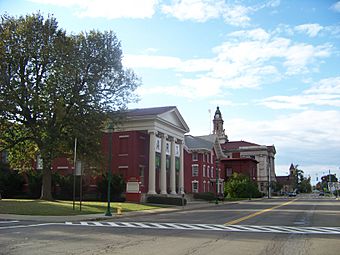Elmira Civic Historic District facts for kids
|
Elmira Civic Historic District
|
|

Looking north on Lake Street, Arnot Art Museum in foreground
|
|
| Location | Elmira, New York |
|---|---|
| Built | 1835 |
| Architect | Pierce & Bickford; Et al. |
| Architectural style | Mid 19th Century Revival, Late 19th And 20th Century Revivals, Late Victorian |
| NRHP reference No. | 80002596 (original) 100004956 (increase) |
Quick facts for kids Significant dates |
|
| Added to NRHP | July 30, 1980 |
| Boundary increase | January 20, 2020 |
The Elmira Civic Historic District is a very special part of downtown Elmira, New York. It's where many important government buildings and cultural places have stood for a long time. This area shows how the city grew and developed its public services. It's like a living history book, showing off different styles of old buildings.
Contents
Exploring Elmira's Historic Center
The Elmira Civic Historic District is a unique area in the city. It was created to protect and celebrate the historic buildings found there. These buildings are important because they tell the story of Elmira's past. They show how the city's government and community life developed over many years.
What is a Civic Historic District?
A civic historic district is a special area recognized for its important history. It usually includes buildings that were used for public services. Think of places like courthouses, city halls, and post offices. These districts help us remember and appreciate the architecture and history of a town. They are often added to the National Register of Historic Places. This is a list of places in the United States that are worth preserving. The Elmira district was first added in 1980. Its boundaries were updated in 2020 to include even more historic spots.
Important Buildings in the District
The Elmira Civic Historic District is home to many impressive buildings. Each one has its own story and unique design. These buildings show different styles of architecture from the past. They help us understand how buildings were designed long ago.
Lake Street Landmarks
On Lake Street, you can find several key buildings.
- The Chemung County Courthouse Complex is a very important part of the district. This is where many local government decisions are made.
- The John Hazlett Office Building is another significant structure. It also serves important public functions.
- The Arnot Art Museum is a cultural gem. It was once a private home but now displays beautiful art. The nearby Icehouse is also part of this historic property.
Church Street Treasures
Church Street also has some amazing historic buildings.
- The Armory Building stands out with its Richardson Romanesque style. This means it has a strong, castle-like look with rounded arches.
- The City Hall is designed in the Beaux Arts-style. This style is known for being grand and formal, often with classical details. It was designed by architects J. H. Pierce and H. H. Bickford.
- The U. S. Post Office is another important building on Church Street. It has served the community for many years.
Other Historic Spots
Beyond Lake Street and Church Street, the district also includes buildings on nearby Baldwin Street, Market Street, and Carroll Street. These streets connect to the main civic center. They add to the overall historic feel of the area.
Why is this District Important?
The Elmira Civic Historic District is important for several reasons.
- Preserving History: It helps keep the history of Elmira alive. These buildings tell us about the people and events that shaped the city.
- Architectural Beauty: The district showcases different architectural styles. It's like an outdoor museum of building design.
- Community Identity: It gives Elmira a strong sense of its past and identity. It reminds people of the city's rich heritage.
- Education: It provides a great way for students and visitors to learn about local history and government.
By protecting this district, the community ensures that future generations can also appreciate Elmira's unique past.



